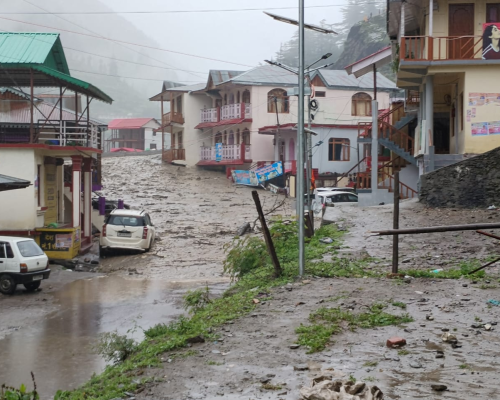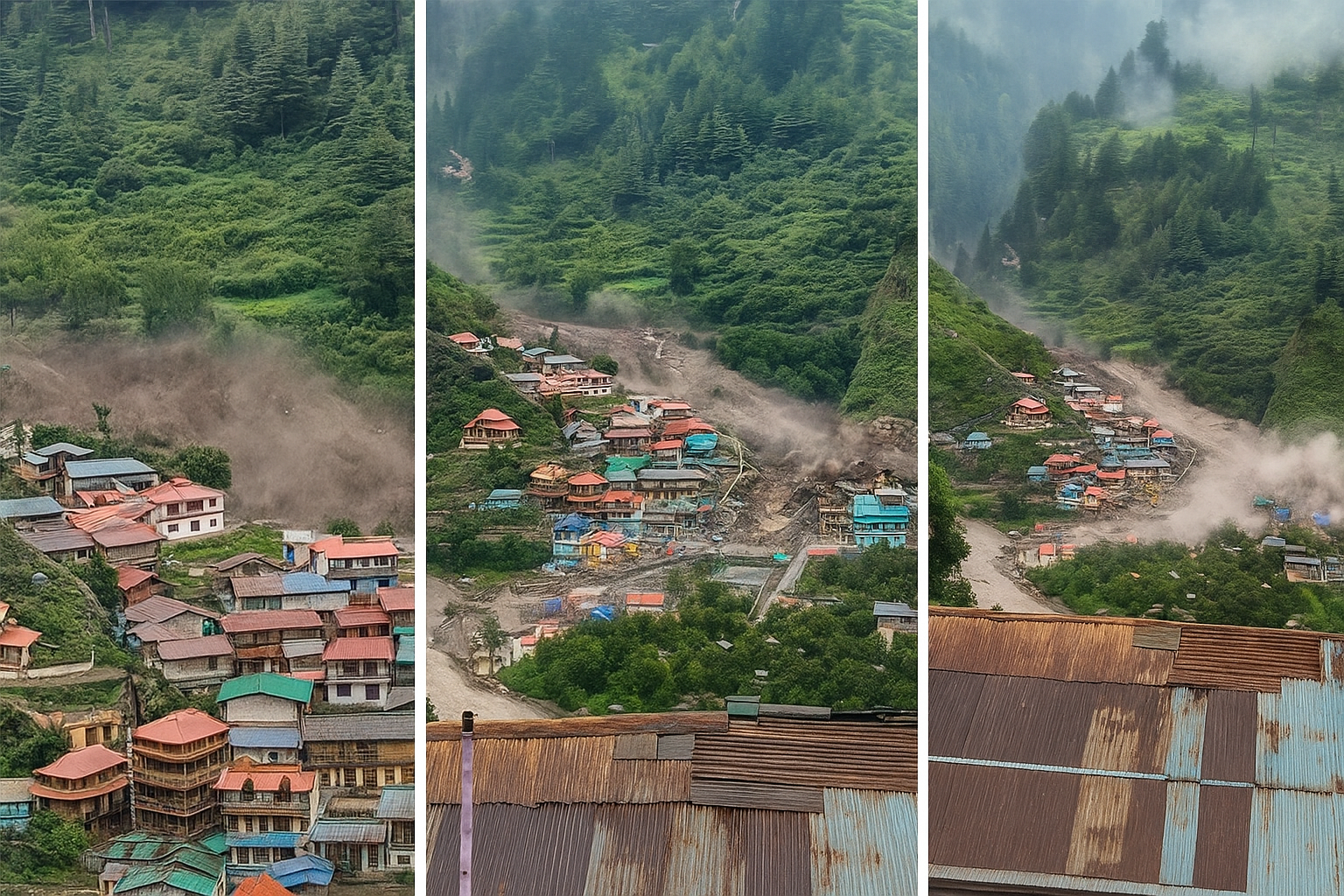Synopsis: In the Uttarkashi cloudburst, 8-10 Indian Army soldiers went missing from the lower Harsil camp. Indian Army, NDRF, and SDRF continue rigorous relief operations, officials report. Why it matters and how we must prepare for the future.
Table of Contents
Introduction to Uttarkashi Cloudburst
Uttarkashi cloudburst: On Tuesday, Uttarkashi experienced a cloudburst, resulting in over 50 deaths from flash floods and mudslides. The Indian Army reported 8-10 soldiers missing from the lower Harsil camp, as per the news agency ANI.
Two cloudbursts have been reported, one that drained the Dharali region and another that hit the Suki Top area.
According to Lt. Col. Manish Shrivastava, “Nine Army soldiers went missing, while two have been rescued so far.” Despite the losses, the Indian Army continued to engage rigorously in the search and rescue (S&R) operation in the region.
The Indian Air Force has been actively on standby with Chinook Mi-17 V5, Cheetah, and ALH helicopters at the Chandigarh airbase for the relief operation in the Uttarkashi district of Uttarakhand. These choppers are in a ready-to-move position, with one command, as soon as the weather clears up, which would help improve visibility for the pilots in the affected areas.
#Uttarakhand cloudburst: Flash floods hit #Uttarkashi; several villagers washed away
— The Times Of India (@timesofindia) August 5, 2025
Know more 🔗https://t.co/BjBg7zAn3Y pic.twitter.com/KAVTdH5yCU
Reasons for the Uttarkashi cloudburst:
The Uttarkashi cloudburst occurred without warning in the Himalayan village of Dharali near Kheer Gad. The event quickly caused water, rocks, and debris to move through the narrow mountain paths.
In mere moments, in Uttarakhand Uttarkashi cloudburst, homes that once echoed with laughter were torn apart. Roads vanished, swallowed by the fury of the flood. Families had no time to gather their belongings, only seconds to run and survive. Heart-wrenching visuals showed villagers scrambling uphill as walls of mud and water crashed behind them. Entire homes disappeared beneath thick, suffocating slop.
Uttarkashi cloudburst: What is a cloudburst? Scientific Explanation & Local Impact
Key Point: A cloudburst is not a thunderstorm or regular rainstorm; it is a highly intense microburst of rain that can drop as much water in an hour as some cities receive in a month.
#BREAKING : Uttarkashi Cloudburst: Army Shares Chilling Footage of Mudslide Sweeping Away Hotels in Dharali.#Cloudburst #Landslide #Uttarkashi #NaturalDisaster #Flashflood #Flooding #Flood #Uttarakhand #UttarakhandNews #uttarkashicloudburst pic.twitter.com/ljFPzgu8bc
— upuknews (@upuknews1) August 5, 2025
Why is Uttarkashi cloudburst So Vulnerable?
The Himalayan region, especially Uttarkashi in Uttarakhand, is geologically unstable and climatically unstable, making it highly prone to cloudbursts.
Here are the 4 major reasons for them:
- Rapid Heating & Cooling: The steep mountain slopes heat up quickly in the day and cool rapidly at night, creating turbulent air that feeds storm clouds.
- High Moisture from Monsoon Winds: Moist air from the Bay of Bengal and Arabian Sea gets trapped in valleys and rises suddenly over hills, forming dense rain clouds.
- Deforestation & Construction: Unplanned development, road cutting, and tree felling reduce the soil’s ability to absorb water, increasing runoff.
- Climate Change: A warming atmosphere holds more moisture, intensifying cloudbursts and increasing their frequency in recent years.
FACT CHECK—Did You Know? Uttarakhand has reported over 200 cloudburst incidents in the last 20 years, most occurring during the June–September monsoon window.
Early Warning System & Preparedness: What Failed in the Uttarkashi Cloudburst?

No official cloudburst warning was reportedly issued before the disaster in Uttarkashi. This is common in Himalayan regions due to the short lead time cloudbursts offer, sometimes just minutes before they hit. Cloudbursts are localized and happen rapidly, which makes it difficult for existing weather models to predict them accurately.
Challenges with Current Warning Systems:
- IMD Radar Limitations: The Indian Meteorological Department (IMD) relies on Doppler radars for weather monitoring. But in mountainous regions, radar signals get blocked by terrain, limiting coverage and accuracy.
• Low-resolution Forecasts: Many forecasts are regional and don’t provide hyperlocal alerts needed in a valley or village-level scenario.
• Communication Gaps: Even when alerts are issued, they may not reach local people on time due to poor mobile connectivity or ineffective local warning mechanisms.
| Year | Location | Impact |
|---|---|---|
| 2013 | Kedarnath | Triggered flash floods, killing over 5,000+ |
| 2021 | Chamoli District | Caused landslide & glacial flood, 200+ deaths |
| 2022 | Amarnath (J&K) | Flash flood swept pilgrims, 16 killed |
| 2023 | Tehri & Uttarkashi | Roads and homes swept, major infrastructure loss |

How can it be improved?
To enhance preparedness in vulnerable Himalayan regions, there is an urgent need to install additional high-resolution Doppler weather radars across hill districts. A specialized forecasting model tailored for Himalayan cloudbursts, powered by real-time satellite data, should be developed.
Integrating AI-driven early warning systems with mobile alert apps can ensure timely alerts reach villagers, trekkers, and pilgrims. Moreover, establishing community-based disaster response networks, where trained local volunteers serve as first responders, can significantly improve ground-level resilience and save lives during such sudden events.
Expert Opinion: Dr. Rajeev Ranjan from IIT Roorkee suggests integrating satellite infrared data with local ground sensors for better detection of cloud formation patterns.
Lessons from Uttarkashi cloudburst: Can We Prevent the Next One?
Cloudbursts are natural events, but their impact can be minimized through sustainable planning and preparedness. Long-Term Solutions like:
• Afforestation & Reforestation: Planting trees stabilizes soil and absorbs excess rainwater, reducing flash floods.
• Eco-sensitive Zoning: Ban construction near rivers and on steep, fragile slopes.
• Climate-resilient Infrastructure: Build roads, bridges, and housing with drainage systems and landslide protection.
• Real-time Data Sharing: Encourage weather data sharing between IMD, ISRO, IITs, and local disaster agencies. Train village-level weather volunteers to record rainfall, temperature, and alert patterns.
Sustainable Tourism Policy:
Tourism in Uttarkashi and nearby regions should be regulated: Limit the number of daily visitors during monsoon. Set up eco-camps with proper waste disposal. Make disaster insurance mandatory for trekkers and tour operators.
The growing popularity of Uttarkashi as a trekking and pilgrimage destination has led to an increase in tourist footfall, even during the risky monsoon months. To minimize the ecological and human risk during extreme weather events like cloudbursts, the following steps should be considered:
1. Limit Daily Visitors During Monsoon:
A cap should be placed on the number of tourists allowed per day during high-risk months (July to September). This will reduce crowding on fragile mountain trails and ease the burden on local resources and emergency services.
2. Set Up Eco-Friendly Camps:
Promote eco-camps that use sustainable building materials and have proper waste management systems. This will minimize pollution and reduce the environmental footprint of tourism in the region.
3. Mandatory Disaster Insurance:
Trekkers, pilgrims, and tour operators should be required to carry disaster insurance. This will ensure financial coverage in case of emergencies and reduce the burden on the government and rescue agencies during natural disasters.
Uttarkashi Cloudburst: Conclusion From Tragedy to Transformation
The Uttarkashi cloudburst is a heartbreaking reminder of how fragile life is in the Himalayas. Entire communities, families, and even brave soldiers were caught off guard by nature’s fury. But this tragedy shouldn’t be just another news story we scroll past—it should be a turning point.
This is our chance to do better.
We need to build a smarter, safer future—using technology to predict disasters, preparing people with better alerts, and making sure the places we love to visit are also protected. Villages in the hills deserve more than sympathy—they need real support, stronger infrastructure, and plans that work.
Tourism, too, must be more responsible. Fewer crowds during risky seasons, eco-friendly travel, and better safety rules can go a long way.
Let’s honor those we lost—not just with silence, but with action. If we act now, Uttarkashi can become a lesson that saves lives, not just a place that lost them.
Frequently Asked Questions (FAQs)
1. What should tourists do during a cloudburst in Uttarakhand?
Tourists should immediately move to higher and safer ground if a cloudburst or flash flood is suspected. Avoid staying near rivers, steep slopes, or unstable terrain. Always follow instructions from local authorities and carry emergency essentials like a flashlight, water, dry snacks, and a power bank.
2. How can travelers stay safe during the monsoon season in Uttarakhand?
• Check weather updates daily through IMD alerts and reliable news apps.
• Avoid visiting landslide-prone areas or narrow valleys.
• Keep a list of local emergency contacts, including hotels, police, and hospitals.
• Travel with experienced local guides and avoid venturing out alone during heavy rains.
3. What causes frequent cloudbursts in Uttarkashi and the Himalayan regions?
The steep terrain, rapid air moisture condensation, and sudden temperature changes in the Himalayas create ideal conditions for intense rainfall over small areas, resulting in cloudbursts. Deforestation and climate change are worsening the frequency and impact.
4. Has Uttarakhand faced similar disasters before?
Yes, Uttarakhand has faced several major disasters due to cloudbursts and glacial floods:
• 2013 Kedarnath floods
• 2021 Chamoli glacier burst
• 2022 Amarnath cloudburst (nearby region)
These incidents have led to massive loss of lives, property, and ecological damage.
5. What should I pack for monsoon travel to Uttarakhand?
• Waterproof jacket or poncho
• High-traction trekking shoes
• Emergency torch and whistle
• Travel insurance and ID copies
• Water purification tablets
• Weatherproof bags for electronics
Project 18 Destroyer: 144 Missiles including BrahMos, Surveillance Power up to 500 km
The GeoLens – India || Defence || Global Affairs

Pratik Kondawale
Strategist | Indian Defence & Global Affairs
Founder of GeoLens.in, Pratik writes in-depth analysis on India’s defence strategy, military tech, and global power shifts delivering sharp insights through an Indian lens.


1 thought on “Devastating Uttarkashi Cloudburst 2025: What Happened, Why It Matters, and How We Must Prepare for the Future”